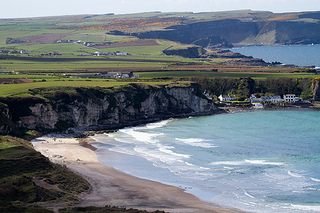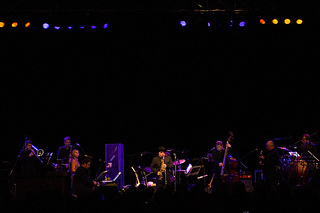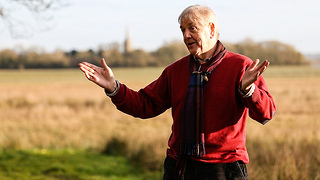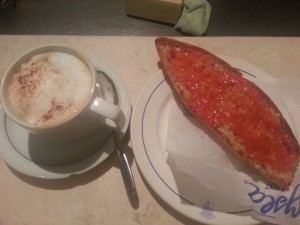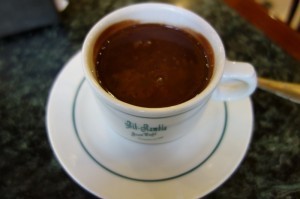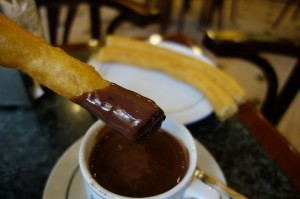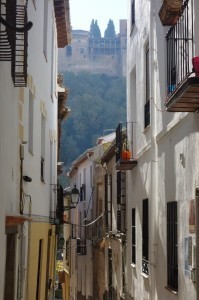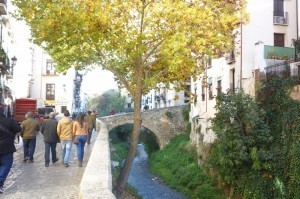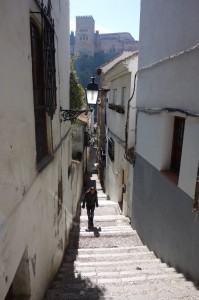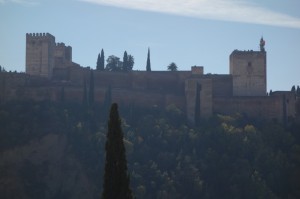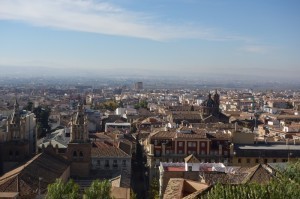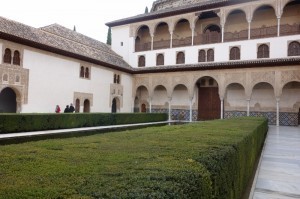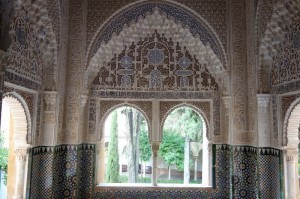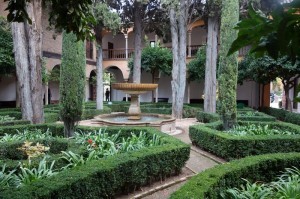Lisa Niver's Blog: We Said Go Travel, page 413
March 7, 2014
What Do Van Morrison, the Godfather of Punk and Seamus Heaney Have in Common?
There is a theory of “primitive affluence” that suggests that when a society has its primary needs met by Nature — food, shelter, clothing — then it will turn to creativity. Bali, a tropical island in Indonesia where the rich volcanic soil produces an abundance of food and materials for fabrics and building, is held as an example. The trope is that “everyone in Bali is an artist.” Yet, while it is true that most everyone spends days carving, painting and dancing, there is very little originality in the products — all are variations on a standard theme, precisely ritualistic, all expressed within rigid boundaries. The island’s most famous dance, Kecak, was created by a German painter and musician, in the 1930s, intended as a performance for tourists.
On the other side of the field, Malcolm Gladwell, the counter-intuitive craftsman, in his book David and Goliath: Underdogs, Misfits, and the Art of Battling Giants,promotes the idea of “desirable difficulty,” wherein disadvantages propel people to extraordinary achievement and creativity.
Northern Ireland may be the poster child for Mr. Gladwell’s theory. About the size of Connecticut, with less than half the population (about 2 million people), it has a wildly disproportionate number of fearless creatives and original thinkers. Yes, it is as far from “primitive affluence” as can be found. The land has few natural resources. Everything from coal to timber to iron has to be imported. For much of the year, the weather is cold and dank. And, for years, the region endured ethno-nationalist and sectarian strife. One rumor has it that when archeologists broke into King Tut’s tomb they found a newspaper with the headline, “Irish Problems Still Unsolved.”
The exceedingly carbonated era that began in 1969, known as The Troubles, ended with the Good Friday Agreement of April 10, 1998, an accord that brought the Peace Dividend, a surge in cathexis with the land, and the beginnings of a surprising renaissance.
Yet, throughout its fractious history Northern Ireland has continued to unleash unreasonable creativity. The Kelvin scale was invented by a Belfastian; the ejection seat, portable defibrillator, modern tractor, the safety lamp for miners and chocolate milk by engineers from County Down. It could be argued distilled whiskey was concocted here, as the flush toilet.
On the entrepreneurial side, Northern Ireland, despite its challenges, became the largest linen producer in the world. And had the largest ropeworks. It was the largest manufacturer of fizzy drinks; largest shirt maker; had the largest flax machine works; largest tobacco factory; largest handkerchief factory in the world. For a time, a century ago, it was the world’s leading industrial city, anchored by the biggest shipyard in the world, and there it created the biggest man-made moving object in history: the ocean liner Titanic.
And then the arts. This matrix of Anglo-Catholic alchemy spawned such as John Butler Yeats, C.S. Lewis, Jack Higgins (who was raised here), Oscar Wilde (who schooled in County Fermanagh), Sir Kenneth Branagh, Patrick Magee, Sam Neill, Liam Neeson, and the most famous film star of the land, The DeLorean. There is not so much sun in this northern clip of the world, so folks are often inside sipping the hot cup of creativity, fanning the flames of magic turf.
When I read, then, that one of my teenage heroes, Van Morrison, was being awarded “The Freeman of Belfast” honor (which allows him to drive his herd of sheep through the center of town), I knew I had to go and jump into this place.
So well I remember standing on the sidelines at a high-school mixer, too shy to cross the room and make the ask. But when Gloria, performed by Them (named for the 1954 horror movie about giant radioactive ants) with the deep burr of Van Morrison’s voice slashing through paper walls, came on the record player, I found a beat and a gift of confidence I never knew I had, and strutted across the floor and asked the most beautiful girl to dance. And she said, “yes.”
I won’t commit the crime of cliché and say his songs were the soundtrack of my life, but there were milestones marked in the Druidic forest trails of his music. “Moondance,” for instance, enabled my own passage to freemanhood, and I’m sure I am not alone in that refrain.
With the first bite of fall I make the pilgrimage to Northern Ireland, to Belfast, where Van Morrison, after a life-time of travel, and living in the artistic meccas of Woodstock and Marin County, has come home, to the place he was born.
I make my way to Waterfront Hall, and settle in just below Violet Morrison, Van’s mom, in the balcony. It’s a family affair, as the chief back-up singer is Van’s daughter, Shana.
Silence, anticipation seem in command. Then The Lord Mayor Máirtín Ó Muilleoir takes the mic, and says, “He united us in the past, he’s united us tonight and he will unite us in the future. This honor represents our love, respect and gratitude for Van Morrison from the ‘dark side of the street to the bright side of the road’.”
And Van the Freeman, six-time Grammy-winner, sporting signature dark suit, black hat and sunglasses, struts out stage left and gives a thumbs up to the crowd. He signs a special scroll, accepts a gold key to the city, bows, and then, without a word, picks up his alto sax, and launches into a sensual Celtic Swing.
And from there into “Moondance,” “Brown Eyed Girl,” and a roll call of greats, many citing patches of his personal map, sign posts and street names from his East Belfast boyhood. Van, of course, remains rock’s foremost curmudgeon, and true to form he lets the music do the talking, rarely speaking, sometimes turning his back to the audience to play.
But at 68, after 50 years as a fiercely prolific artist, he still summons the nerve to sing about the world as if it remains to be made, or as if it could be unmade, something he’s witnessed in his hometown. As so many in Northern Ireland, he rattles the door of convention in its frame. And as he growls his lines, making himself into a sea monster, his daughter Shana swoops over him and digs into the songs, adding fervor in a glittering dress.
Just before Into the Mystic, The Belfast Cowboy sits down and jests: “This is the part where I hide behind the piano.” A German journalist next to me, who has been to a score of Van’s concerts, turns to me shocked and says “that’s the most he’s ever said at a concert.” Then the piano takes off, like a boat untied, into waves of melody. There is the feeling that Van is looking back at his dock from a future already passed.
This is a “hand of history” moment in Belfast. We’re immersed in something called “yarragh,” — fleeting elusive moments of transcendence, when the sense of an unrepeatable event is present. Like the city itself, this is an irresolvable adventure, someplace between the breaks and holes in the music.
He ends the municipal tribute with a muscle and fiber rendition of “Gloria,” and I am transported back, as no doubt many in the audience, to teendom, to that moment when we loosed ourselves from words and floated on the bowers of his music.
Van is now a Freeman of Belfast, which is doubly significant, as just a few years ago men were not free to walk this city, and now they are.
–
The day after the concert I head out to meet another cyclone-in-residence, Terri Hooley, the “godfather of punk,” at the latest awakening of his record shop, Good Vibrations, with its 1955 Elvis effigy out-front. He is still, after all these years, hawking vinyl, posters, and the trending whiffs of the ’70s. He insists we head over to the pub for a pint of Guinness with a brandy chaser, his preferred poison for the last half century. He lost an eye with a stray arrow as a boy, and has a reputation for plucking out his glass eye and dropping it into a drink, so I keep my pint out of reach. After a sip or few he shares, “I honestly believe punk bands saved countless lives, keeping impressionable young people away from the paramilitaries and giving us all something exciting to focus on.”
Terri Hooley first opened his record shop on Great Victoria Street in 1976, at the time the most bombed piece of real estate in the world. It quickly became a safe haven, a neutral harbor, at a time when things were very thin on the ground. Teens and lost tribes from all sections and classes, from both sides of the divide, joined by a love of music, hung out in peace, preferring tunes to stones, music and culture more than the dead hand of sectarianism. It was a firefly of light in the blackness of Belfast at the time.
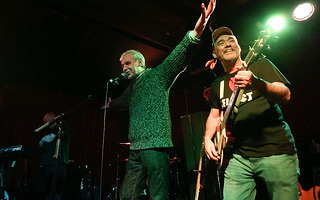
Though a Hank Williams fan in a polo neck, when he heard Punk it screeched his being. “To be a punk was to be different from the past.” He started his own label, and produced edgy, alternative records. “Teenage Kicks,” by the Undertones, was his biggest hit. He took the record to London and pedaled it around, but no one bit. “They said it was the worst record they ever heard in their lives.” Then John Peel, the rock-star DJ, played it on the BBC, twice, in a row, and the Undertones were signed to a major label. Hooley never did it for the money — his store has gone bankrupt more times than the airlines — and he still doesn’t have any savings, but his unending efforts to build peace through music are recognized now around the world. “My brother was addicted to heroin; I’m addicted to having a record shop.”
“For such a small population we have more talent per head of poets, painters and performers than anywhere else in Europe. Because of our in-between status the arts give young people something to be proud of. It proves to every kid here that he can achieve something, and have a bloody good laugh doing it.” Terri Hooley
Terri has a sign in his store at the top of the stairs, “Help the Aged Appeal. Don’t let the elderly be on their own. Support this lonely old man by coming to hear him play his golden oldies every Thursday night at the Voodoo.” I ask Terri if he still pogoes, and his eyes light up (well, his eye actually), and with a quick smile, up and down he bunts, like a kid on caffeine.
–
I make my way back to the Europa, once the most shelled hotel in the world, now a chic boutique. Along the way I pass the Albert Clock, which lists like the leaning tower of Pisa. It not only has the inclination, it has the time.
And I take a stop at the storied Ulster Hall, the Grand Dame of Bedford Street, where if the walls could talk, they wouldn’t talk, they would sing. Glenn Miller performed for American Troops stationed in Belfast preparing for the Normandy invasion of 1944 (a local saw at the time: The Americans are “oversexed, overpaid and over here; the Brits are undersexed, underpaid, and under Eisenhower); Paul Robeson bellowed Old Man River here. The Rolling Stones, in 1964, played their shortest set, 13 minutes, before hysterical fans broke up the show. Led Zeppelin debuted Stairway to Heaven here in 1971 to an unimpressed audience. The Clash were due to play in 1977, but when insurance was cancelled for the gig, hundreds of disappointed fans rioted. Terri Hooley said it may have been “the only riot of the Troubles where Catholics and Protestants were fighting on the same side.”
–
That evening its back to Waterfront Hall, this time for a concert celebrating the man who threw a net across the world with his poetry, Seamus Heaney, the Nobel Prize-winner who died in August 2013 at 74. His final message to the world, written in Latin just minutes before he passed: ‘Noli timere’, “Don’t be afraid.”
The main presenter is Belfast-born actor Stephen Rea (were you surprised in The Crying Game?), who enjoyed a 35-year relationship with Seamus. They both served as directors of the Field Day Theatre company, which they saw as a “direct intervention” of art and culture during The Troubles.
Mr. Rea takes the first lines flatly, simply, as though he has too much respect for the words to add theatre. He seems to know that any phrase he renders is guaranteed to perfume the room, and so keeps the oil light.
But as the evening progresses Mr. Rea becomes bolder, pressing the words like bricks, then flies over verses towards some unreachable shore of release. When he lights on certain sounds, certain small moments inside a poem — hesitations, silences, shifts in pressure, sudden entrances, slamming doors — they suggest whole territories, completed stories, indistinct ceremonies, far outside anything that can be literally traced into the compositions that carry them.
It is, in the end, an evening made of fragments, alternating between the textures and cadence of Seamus Heaney’s words, and music that seems to have floated up between his lines. There is in his poetry a kind of quest, and from the moment his words are voiced everything is transformed. There are moments when I feel a realm beyond ordinary expression, reaching out as if to close my hand around it, but then I would open my fist, to find… a butterfly within.
The next day, into the crisp morning air, pointillistic with mist, I head out on a guided tour of Heaney Country in County Derry.
Seamus Heaney Country. Photo by Laura Hubber
My guide, Ken McElroy, is a poet unjustly unsung, with a voice that takes up more room in the car than seems legal. He also teaches me the difference between prose and poetry with an example:
“Two brothers named Pollocks
Who were both alcoholics
They went for swim
The tide came in
And the water rose to their… knees.
Another 12 inches and it would have been poetry.”
Ken drives, retracing Seamus’s schoolboy footsteps along Lagan’s Road, where he walked his first date with wife-to-be, Marie. We roll by the blacksmith’s shop at the Hillhead, the inspiration for the poem The Forge, and as I draw a breath I know I am breathing Heaney history, along with the air, and smoke. We wade into a marsh with an overlook to a steeple that looks beckoning, like a bent finger. It is Church Island, about which he wrote the eponymous ode:
“Where you weren’t known and far from what you knew:
The lowland clays and waters of Lough Beg,
Church Island’s spire, its soft treeline of yew.”
We visit next The Turfman Statue in Bellaghy. The eternal seems to be riding the back of this bronze life-size representation of his most famous poem, “Digging” fromDeath of a Naturalist. The word “poem” seems much too small, considering it was written when 27-years-old, with lines that distinguished his life from his farmer father, and forecast his own future:
“Between my finger and my thumb
The squat pen rests.
I’ll dig with it.”
Ken clearly relishes untangling the places that inspired the local laureate. Almost as pretext he explains, “Though he became internationally regarded, and held chairs at both Oxford and Harvard, he never really forgot his roots. He always identified with this small part of Ireland where he grew up.”
We make our last stop at Bellaghy’s cemetery. Seamus wanted to be buried in his own clay, in a family plot here. It takes a time to find it. Tucked away it is, in a quiet corner, festooned with one yellow bouquet of flowers taped with an anonymous note, “Thank you for the poetry.” Just to the side is a white and black sign with an arrow pointing his way, “Car Park.” He would have liked that.
–
Sometimes when a landscape broods music heard faintly on the edge of sound, others beyond notice, and seek their own muse in that place.
And so such it seems when the leaders of the free world chose the Lough Erne Resort, in Enniskillen for the 2013 G8 Summit. Such a gathering in Northern Ireland would have been inconceivable during The Troubles, but now the place has the draw of peace and bonny fairways, as well as identical lodges so none of the leaders could be jealous over the size or amenities of their peers.
I make my way to the castle-like resort, set on its own 600-acre peninsula, and a sign that instructs, “Ssshh… Bats Sleeping.”
After checking into the Old-World style room, I pass through the Thai Spa (if anything, Northern Ireland relishes appositions) and stop in the Blaney Bar. I sidle up to the rail across from a flickering beech log fire and order up one of the 101 Irish whiskies on the shelf, “on the rocks.” But the barkeep refuses. “You can’t order whiskey with ice here,” he scolds. “Remember the Titanic,” and he slides over a straight-up glass, leaving me to drown in my error.
Photo by Laura Hubber
Later I catch up with John O’Naill, a manager at the property, and ask about the summit.
“It was a dream event for us. Strangely enough, the golf course proved to be a suitable place for everyone to land by helicopter, so at one stage there were 22 helicopters on the ninth hole, lined up side by side. President Obama said he brought the shoes, but nobody had brought his clubs, so he couldn’t play golf. But he did walk the first four holes of the course.” I take a tool around the course in a golf cart, and it is, I can affirm, a fairway to heaven.
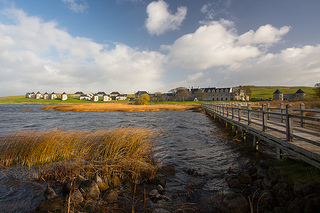
It is in this conducive environment that the world leaders tackled tax evasion, transparency, trade, the Syrian civil war, ending payments for kidnap victim releases, and something else of import — let me think — finding a cure for dementia by 2025.
At the Catalina Restaurant that night, over a heavenly loin of Fermangh lamb with Dauphinoise potatoes, that would fell lesser men, I try to sort out this place, Northern Ireland, and why it is such a seed-bed of creativity and enterprise. There are, it seems, natural, limbic connections that reach back to the basement of time. It’s the earned distance of this place, floating in the upper latitudinal reaches, where all the winds of the world pass.
But the strategic positioning of its capital as a port also plays a role. With the comings and goings to far-flung lands, an outward-looking ethic is a natural byproduct, an ability to assimilate and re-purpose the ideas of the world. The passing ships were in a way like bees pollinating flowers in a garden far from where they started, bringing different music, dance, foods, customs, crafts, beliefs, politics and new human constructs — and leaving behind the recipes for creativity and ingenuity. Van Morrison’s shipyard-worker dad is an example. He brought home stacks of 78s and LP records from across the oceans — blues, ballads, gospel, skiffle, folk songs, protest songs, work songs, cowboy tunes, Ray Charles (with whom Van later collaborated) — and Van soaked them up, mixed and fused them in his mind, and from them began to form his own inimitable sound.
The ports of this land allow a heightened awareness of the rest of the world, an ability to witness, often firsthand, what is working and what is not on the global stage, and to behold the interconnectedness of all things. It allows Northern Irelanders a visionary perspective — to be able to skate to where the puck is going, not to where it’s been.
And then there is the weather. When there is constant comfort, such as in the tropic zones, there is, some theorize, little incentive to boldness, little inducement for the rage to master. Imaginations turn to ice.
Yet here, the cold, the damp, the rain, they have conspired to ignite a creative “big bang” in Northern Ireland.
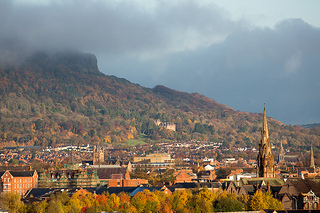
Finally, there are the intangibles of social, religious and political dynamics that generate virtuous circles of cutting-edge novelty, a culture of competitiveness, and aspirations. Folks here have learned to do more with less, and exceptionally so.
These, perhaps, are the “desirable difficulties,” the advantages of disadvantages, the elements that provoke imagination and resourcefulness, inventive ways around rough hands that might be dealt. These have collaborated to vault Northern Ireland to a place of high originality; and a place to visit to steep in the beauty, music, architecture and poetry of its natural and man-made creations, and to be, quite plausibly, so inspired. There are Ulsterior motives here, as well. The winds make us lean towards this place, to inhale its spirit, and the broken waters summon us to baptize our dreams, and, in our own foreign way, contribute to the exquisite idea that is Northern Ireland.
The author and Jasper Bangs wandering Northern Ireland. Photo by Laura Hubber.
The post What Do Van Morrison, the Godfather of Punk and Seamus Heaney Have in Common? appeared first on We Said Go Travel.
The Wilderness of No Regrets in the United States
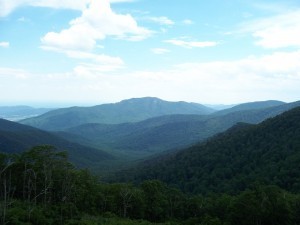 Although I’m sure that for some people there is one place that comes to mind when they think about where they would wish to spend their time, that statement simply isn’t true for me. There are far too many incredible sights to see even in our small corner of the world. For now I spend my vacation days, however few and far between, finding a new outdoor wilderness to explore. The United States is home to fifty-nine National Parks and over six thousand State Parks. The number of trails to hike feels endless, and yet ripe with possibility. I often wonder if I will ever have the time to see them all.
Although I’m sure that for some people there is one place that comes to mind when they think about where they would wish to spend their time, that statement simply isn’t true for me. There are far too many incredible sights to see even in our small corner of the world. For now I spend my vacation days, however few and far between, finding a new outdoor wilderness to explore. The United States is home to fifty-nine National Parks and over six thousand State Parks. The number of trails to hike feels endless, and yet ripe with possibility. I often wonder if I will ever have the time to see them all.
There is nothing quite like waking up to the sound of birds chirping while the cool morning air rustles the sides of my tent. The day simply inspires me to rise earlier and happier than I would at home. It is as though the wild beckons me to become a part of it, to take a deep breath and go exploring. Each campsite, trail, and mountain peak is unique and special in its own way, and each pulls me with a magnetic force I can’t resist. As someone who can’t stand to wake up before ten am, rising without an alarm at seven seems like a miracle all on its own. The smell of last night’s campfire lingers in the air and the early morning dew still clings lightly to everything the sun has yet to touch. The excitement at camp is palpable as one camp mate scurries to relight the fire and another begins preparing the morning meal. There is so much possibility born in each day, and I look forward to making memories as I explore the lands around me.
These places, whether nearby at Highlands Hammock State Park or far away in the Black Hills of South Dakota, erase feelings of pressure and deadlines from my mind, inspire creativity and curiosity, and leave me blissfully exhausted when I return to camp in the evening. There is so much to do and see, yet the typical feelings of being rushed and unable to relax are gone. Yet another miracle of the woods. Sometimes I bring my camera, the fancy one I never have time to play with at home, and take photo after photo in a desperate attempt to preserve the brilliance I see. Other times I rely on my eyes and memory alone to capture the beauty around me and relish the gentle hum of life within the trees.
Being away like this encourages me to rely on instinct, to try new things and push myself to new limits, and even to share a little more openly around the campfire. There is something pure and freeing about the wild that makes baring my soul and being honest with myself more bearable. Trips like this remind me how small I am in comparison to the world around me. It reminds me that there are bigger things in this world to concern myself with than whether I improved on my most recent performance evaluation or whether I’m driving the newest car. Walking these trails, exploring our country, makes me realize what living life is truly all about. How can anyone be filled with regret when remembering times shared with loved ones, hiking the beautiful trails of the Blue Ridge Mountains or stargazing in a field without a trace of light pollution? Life should be about balance and peace. For me, finding my balance and inner peace comes when I am able to quiet my mind in nature and just be.
About the Author:Jessica Van Eerde is a 30 year old attorney who spends far too much time in the office and not nearly enough time exploring the world. I love to hike, camp, take pictures, and write, and I’m constantly trying to find time for everything!
Thank you for reading and commenting. Please enter our next Travel Writing competition and tell your story.
The post The Wilderness of No Regrets in the United States appeared first on We Said Go Travel.
March 6, 2014
My Mind, I Took It Home to Korea
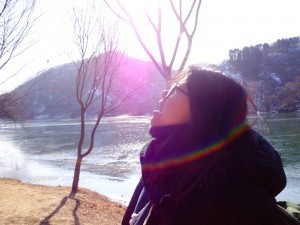 I have never been celebrated Winter in my life. I am from Indonesia, a very tropical country with never ending summer. Truthfully the idea of having winter is always on my mind. I always want to go to Iceland or even Greenland just to feel some winter euphoria. Then, I decided to go to South Korea this winter. South Korea is the closest place to feel the winter from Indonesia.
I have never been celebrated Winter in my life. I am from Indonesia, a very tropical country with never ending summer. Truthfully the idea of having winter is always on my mind. I always want to go to Iceland or even Greenland just to feel some winter euphoria. Then, I decided to go to South Korea this winter. South Korea is the closest place to feel the winter from Indonesia.
I arrived at Busan, I planned to took a bus to Seoul from Busan. When the flight attendant opened the airplane gate, all i felt was “This is no joke” I said that to my friend. I kept wow-ing wherever I go because that was totally different from my country. The weather, the people, the technology was completely insane. A that time, the weather is really cold, about -12 celsius degree tops.
At Day 5, I had the opportunity to visit Nami Island, located at Gangwon Province, not so far from Seoul. I always enjoyed scenery wherever I go. Nami Island and its neighborhood is really breathtaking. The place is also colder than Seoul. There was so many tourist back then. But, believe or not, they are local tourist from so many province in South Korea. I managed my self to ask one local tourist who speak English about Nami. He said, “I’ve been to Nami like 5 times, but I never get bored. This is my country’s asset, how can I miss?”. I don’t know but at that time while hear his answer, at that perfect scenery of Nami, all I think about is my home, Indonesia.
South Korea has so many great places such as Jeju, Nami, Mount Sorak, etc. South Korea also has “hallyu wave” for korean pop and korean drama which led so many tourists to visit this country. There’s so many westernization things also, but the people are very nationalist about their country. They love their country so much.
I looked up into myself. Indonesia also has so so so so many place to be explore. But I always wanted to go overseas because of many reason. Other than Bali, Indonesia has Raja Ampat Island, Borneo with their rich culture, and the beauty of beaches since we are “Island Nation”. When I was in Nami,all I think about is, “After this, I will go to the Gili, West Nusa Tenggara and walking through the sand while carry my sandals and wear my thin shirt”. I realized that I went away too much. I realized that there is so many things in Indonesia that you can actually do. And somehow, I feel lucky to have summer all the time. Because feeling cold is the last thing that I want after I felt all that coldness in South Korea. But yes, still I want to go to Iceland.
Then I went home, to where I belong. Thank God that I had the chance to go to South Korea. Because the people made me realize that I should explore my own land before I go abroad.
South Korea is giving me this idea. For my next trip, I already plan to discover Java, Bali and West Nusa Tenggara in a month. Wish me luck!
By Naresawari Notoprodjo
Thank you for reading and commenting. Please enter our next Travel Writing competition and tell your story.
The post My Mind, I Took It Home to Korea appeared first on We Said Go Travel.
Memories galore on the beach in India
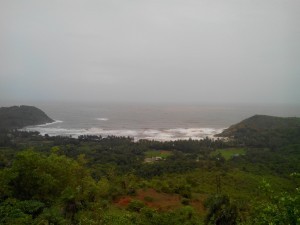 A mélange of emotions, potpourri of feelings, intellectual discussions to the usual female characterized jibber jabber, unrestrained gastronomic delights, spiked with the sense of liberation all jam-packed in one weekend.
A mélange of emotions, potpourri of feelings, intellectual discussions to the usual female characterized jibber jabber, unrestrained gastronomic delights, spiked with the sense of liberation all jam-packed in one weekend.
An impromptu decision to break free from the week-long monotonous life and to explore something new had us booking tickets to Gokarna.
Gokarna, a small town houses many beaches like the Om beach, Kudla beach, Paradise beach and many temples. The best time to visit it is from November to March, it is when all the vendors are geared up for the visitors and the waters get placid becoming more inviting. It looks like Goa during the older times.
With not much time on hand, we packed hastily, slept late but had to wake up early to catch a train from Mangalore. We include me and my roomies. We boarded a 6 am train, had two berths to ourselves and spent the four hours of our journey by narrating happenings, experiences and sharing tips, all these besides pulling each other’s legs as hard as we could.
Gokarna station was unusually quiet (because of the off-season. Yes, our spontaneity landed us there during July) with only a very few people around who had come just like us.
From there the best way to get to the city is to take the auto rickshaws and the minibuses stationed outside. Haggle! Yes, we did and settled for a rick who agreed to take us to Om beach, at a distance of 19kms for 250 bucks. These ricks are customized, the curtains and doors protect you from the rains and the bumpy roads (You can be sure u won’t fall off the auto).
If you are adventurously inclined, you can also opt to trek from Murudeshwara (a famous temple devoted to ‘Lord Shiva’) to Gokarna.
Gokarna has visitors all over the year, few come just to enjoy the serenity besides doing their jobs on their laptops while the others come during the season time to witness the Nature’s beauty in its full glory.
Our accommodation was on the Om beach (named due to the formation of rocks in the divine ‘Om’ shape), provided by the ‘Namaste café’ where we ate most of the time. Refreshed, we started out to the city to visit the town. The temples here are very famous and the roads are laced by numerous shops selling trinkets.
After shopping and going around for a while we returned to our room, left our bags and headed out to the sea. Soon, we were a part of a pretty animated picture painted by nature with a strikingly beautiful sunset in the backdrop of the gushing waves. The transition from the drizzle to the downpour had us gamboling around and embracing the beauty.
As it got duskier, we returned back to our room to wash the sand off us and to get ready for dinner. Dressed in pretty frocks and accessories we did make many heads turn when we entered the café for dinner. We occupied the only vacant table. The ambience was aesthetic immersed in yellow lights from electric lanterns hanging from the roof against the darkness of the open. The light music, soft voices of people around besides the sound of the sea upped its charismatic appeal.
The café on the beach, also frequented by foreigners, knows how to please all. It has a nice delectable menu to choose from. With a light dinner we retired to bed. Next morning, after gorging on an elaborate English breakfast, we headed out to the beach. The tides were high in the morning, so we maintained ourselves to the shallow area and had our ‘photo session’ as we call it.
Kudla beach can be reached from here by a walk of twenty minutes. The route starts with a staircase leading to an open ground and climbing down to the beach. During season time, it is very beautiful with many interesting stalls on the beach and facility for water sports. You can visit Paradise beach too in the season time.
The best part of the trip was that it dint seem like two-days, it felt longer with so many phases packed in so well, from leg-pulling, laughing silly, contemplating about our problems, sharing our goals, discussing current affairs, to deciding upon the next-place for getaways. The entire trip was liberating, energy-filled, carefree and a guilt-free indulgence. The holistic appeal of this place is so surrealistic that it is thought-invoking and you are sure to connect to yourself, a dose of this which I feel is needed adequately to keep us inspired and well going.
All in all, times well spent like this are sure to be an everlasting etch in our brains, something that we’ll cherish years later like a winning trophy.
About the author:
Hi, I am Naimesha Thakur, from India. I love travelling, exploring new places and writing about them. I am working as a software engineer.
Thank you for reading and commenting. Please enter our next Travel Writing competition and tell your story.
The post Memories galore on the beach in India appeared first on We Said Go Travel.
Spain: Glorious Granada – The Albaycin and The Alhambra
While visiting Spain, I found myself with two extra days between my visit to Ribera del Duero in the north and Sevilla in the south. There were so many places that I wanted to go as I hadn’t been to Spain in many many years. Looking at the map, Granada seemed like the perfect place to go for a couple days and it was the best decision I made.
From the moment I got into a taxi at the train station, I began to fall in love with Granada. It was 10pm at night and the city was alive. People were walking along the streets and the lights were lit up (afterall, it was early December so the holiday season was in full swing).
I had found a room at the Vincii Hotel Albaycin. Centrally located, it was quiet with modern accommodations. I woke up the next morning and took a run along the jogging trail that is only a couple blocks from the hotel and runs along the river. After loosening my legs for a long day of walking, eating, drinking and sightseeing, I stopped into the bakery across the street from the hotel for pane e tomato and a café and was then on my way.
As I walked through the streets from my hotel leading to the Albaycin, I made a quick stop in the Bib Rambla at the Gran Café, Granada’s oldest café, for churros y chocolato.
With a full belly, I continued to the Albaycin, the historic Moorish area. I passed through the Paseo de Las Tristes, along the river and then wandered through streets and the up hills.
At the top of the Albaycin, you are able to see some of the most magnificent views of the Alhambra and of the city of Granada.
After a morning walking around the Albaycin, I walked back down the hill to catch a bus to The Alhambra, a palace and fortress originally constructed as a small fortress in 889, renovated and rebuilt in the mid 11th century by the Moorish king Mohammed ben Al-Ahmar of the Kingdom of Granada, then converted into a royal palace in 1333 by Yusuf I, Sultan of Granada and later occupied by Christian Royalty in the 15th century. I highly recommend making a reservation in advance as tickets sell out. Once you have a ticket, a minimum of 3 hours is needed to wander around. The audio guide was very useful as I strolled through the magnificent structure.
After a long day of walking around, stopping for tea at one of the many Tea Houses in the Albaycin is a great idea. I stopped in the Teteria Nazari, open 2pm to 12am, a cozy, dark Moroccan/Arabic space with couches lined along the walls and ordered a regional tea (marroqui te verde y hiebabuena) and shubakla (a pastry with honey and sesame).
To finish off the day, I wandered over to the Hammam, the Arab bathhouse located just off of the Plaza Nueva, for my 8pm reservation. The Andalusian architecture and music transports you to another place and time. I relaxed in the hot pool, warm pool and cold pool, as well as the steam room, until it it was time for the massage, accompanied by oil scented with rose, lavender, violet or jasmine. The perfect end to an amazing day in Granada.
The post Spain: Glorious Granada – The Albaycin and The Alhambra appeared first on We Said Go Travel.
Welcome to South Africa
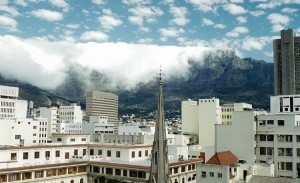 My legs burn like ovens, and I sit, drinking in the view, ignoring the pain. Two hours of plodding up Table Mountain, up the stone stairway for giants, my knees rising to my chin, my hands scrambling; fit, young fathers with babies in backpacks striding past me; me striding past chubby teenagers and middle-aged hippies stooped over their knees and straining air through their teeth like steam-engines.
My legs burn like ovens, and I sit, drinking in the view, ignoring the pain. Two hours of plodding up Table Mountain, up the stone stairway for giants, my knees rising to my chin, my hands scrambling; fit, young fathers with babies in backpacks striding past me; me striding past chubby teenagers and middle-aged hippies stooped over their knees and straining air through their teeth like steam-engines.
I sit on the table top and pull off my Blundstones–seven bucks from a second-hand store in Adelaide six years ago–and peel off my stinky socks. The cool air is a healing balm, and my toes wiggle a happy dance. I shiver with the mucky chill of cooling sweat. The wind tosses my hair like a tease, and I pull my cap on to stop my hair from lashing my face.
The white roofs of Cape Town are like snowflakes, and beyond, the turquoise sea impossibly clear, the flashes of waves like glitter in the sun. And then the mighty Atlantic draws my eyes to foreverness lost in the salty haze.
The descent compounds the agony, but I move differently now, sideways, like a long-legged crab. Tumbling down, keeping my legs straight when the topography allows it to lessen the screaming in my hamstrings and quadriceps. I don’t stop. I zip past the puffing, panting climbers yearning for oxygen, and when I reach the flat and glide down the sidewalk like a skater who moves with minimal effort, the pain is not so bad. I am on air.
The houses are high-walled and brick, strung with barbed-wire or pressed with broken glass, tiny deadly razors arranged like mountain ranges. There is no wind, the sun burns the sides of my neck, and I shiver, but not with cold. I glance nervously at the wall beside me and the line of razor wire that runs along the top, trusting that if an edgy homeowner is lurking in the garden with a shot-gun, my color will save me–at least in this part of town.
My feet are roasting. The ball of my left foot falls into a hole, but when I look down, I see a strip of rubber flapping from the sole of my boot, and I stop to consider the chunk of black two steps behind me. My boots are melting.
I walk like a stick-insect with boots flapping as if a shag is stuck to my foot with bubble gum. The sun tears at the exposed skin of my forearms and legs, and I hope I am wearing enough sunscreen to stop me from burning and blistering. My throat is dry, and I swish the last of the water around my mouth before swallowing, and then tuck the empty bottle back into my daypack.
I imagine my sister in the air-conditioned hotel, mixing with other academics, discussing her thesis; networking. She will be in work mode for another few days yet, doing what people do at conferences, and then our adventure will begin. We will hire a car and drive to Namibia. Just like that. That is the plan.
The sun creeps around the edges of my cap and nips at the side of my neck, just above the line of my t-shirt. The steaming pavement slices another strip of rubber from the soles of my boots.
Table Mountain looms over me now, the flattop cutting a magnificent line across the blue as a pedestal to heaven. At last, a hint of a breeze picks up. Soundlessly, it taunts me and my silly, flapping footwear, but if I listen carefully, I can hear the promise of wonder in days to come.
Welcome to Africa.
About the Author: E. M. Eastick worked as an environmental professional in Australia, Europe, and the Middle East before embarking on the writer’s journey. She currently lives in Guam.
Thank you for reading and commenting. Please enter our next Travel Writing competition and tell your story.
The post Welcome to South Africa appeared first on We Said Go Travel.
March 5, 2014
OBUDU MOUNTAIN RESORTS: NIGERIA’S LAND OF BLISS
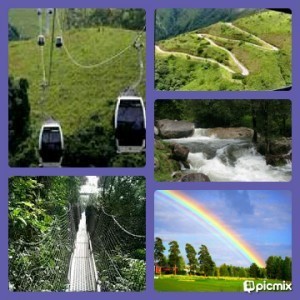 The driver, a wiry balding middle-aged man, whistled to a tune from “sweet mother”, a popular high life music playing on the stereo of the Toyota Sienna mini-van. He seemed unperturbed by the screams and rants of the passengers, most of whom like me were making their first-ever visit to the hilltop, as the car sped along the torturous road with its sharp bends.
The driver, a wiry balding middle-aged man, whistled to a tune from “sweet mother”, a popular high life music playing on the stereo of the Toyota Sienna mini-van. He seemed unperturbed by the screams and rants of the passengers, most of whom like me were making their first-ever visit to the hilltop, as the car sped along the torturous road with its sharp bends.
A wave of nausea hit me, making me clutch the head rest like it was a life line. I closed my eyes and moved my lips in a silent entreaty to God, asking Him to see me safely to my destination. “We have just passed the devil’s elbow. The mother of all bends”, announced an excited old timer in a deep baritone voice that would have made any choir proud.
A few minutes later, with my eyes still closed, I felt the car jerk to a halt. Not sure whether to open my eyes or not, I held tight to the headrest, fighting the nauseous feeling that was threatening to overwhelm me. Someone tapped me on the shoulder and my eyes opened to behold a pretty faced lady, dressed in an olive green turtle neck sweater and a pair of printed pants, smiling at me. I managed a weak smile back at her, embarrassed she had seen me in my not so good moments. “You may want to come down now, sir”, said the lady, seeming not to notice my embarrassment. I mumbled a thank you and alighted from the mini-van.
Taking in deep breaths of the clean and fresh mountain air, helped to quell the nauseous storm that was brewing inside of me. After checking in, I changed into a pair of shorts and boots. Armed with a pair of binoculars, a camera and a back pack, I set out to explore the resort. The journey to the Obudu Mountain Resorts had first begun the day I watched a documentary on the resort and all its beautiful features. Now standing here looking at the idyllic scenery of one of the most the most magnificent tourist destinations in the world today, situated deep in the tropical rain forest of the Cross River State of Nigeria, I knew that the media had been right when it dubbed the resort: “an abode of the gods”.
The air was filled with the sweet scent of flowers in bloom. There was this peace and serenity about the place that made you feel like you were one with space. Time simply did not exist at that moment. From the canopy walkway, situated in the trees, that allowed visitors to have a thrilling close up of birds in their natural habitats high above the ground. To the breathtaking waterfall with it beautiful streams, to the arc of rainbow (this I learned from the locals was a frequently occurring phenomena) that made the forest burst into a myriad of colors. Everything seemed like a plot from an enchanted story. The thrill did not stop there. I rode the 4 km long cable car and visited the bee farm, where pure honey was produced on the resort and exported to other countries.
My visit to the mountain resort was an exhilarating experience that taught me so many amazing things about nature and I also learned to respect and appreciate it. Like everything that has a beginning, my stay at wonderland had come to an end and I was ready to embark on my journey back home but not without the beautiful memories of a time well spent.
Thank you for reading and commenting. Please enter our next Travel Writing competition and tell your story.
The post OBUDU MOUNTAIN RESORTS: NIGERIA’S LAND OF BLISS appeared first on We Said Go Travel.
The Road to Everywhere in the U.S.A.
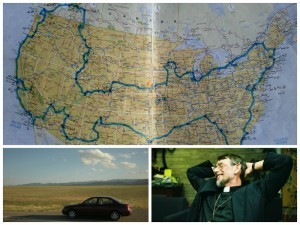 As the van pulled away, I stood on the porch of my Nebraska home and wondered what life would be like now that I was fatherless. After three years of watching him suffer through chemo, radiation and surgery, I came home to see a hospice van sitting in my driveway, and knew it was over. I was just 19 when cancer took my dad.
As the van pulled away, I stood on the porch of my Nebraska home and wondered what life would be like now that I was fatherless. After three years of watching him suffer through chemo, radiation and surgery, I came home to see a hospice van sitting in my driveway, and knew it was over. I was just 19 when cancer took my dad.
But the premature loss wasn’t exclusively mine. Only 58-years-old when he passed, my dad should have had plenty of quality years left. He loved his job as a pastor, he loved his family, and he loved long road trips: something he was looking forward to doing a lot more in retirement.
But he never got to experience that retirement. He never got to use any of the money he’d saved, never got to live in the Florida retirement house he’d built with his own hands, and never got to spend those hot southern afternoons tinkering with his beloved 2001 Hyundai Elantra–which he planned to keep running deep into those post-work years.
Working as a pastor meant that my father’s service to God far surpassed any adoration for money. So a few days after his funeral, instead of stock options or a house, I inherited that Elantra–tattered from years of prairie hail storms and matured to 68,000 miles. Staring at the model-car he kept by the odometer and smelling the lingering fumes of his pipe, I didn’t exactly know what to do with my dad’s Elantra.
So I drove.
I got in the car and took my first independent road trip. It was the only thing I could do to both honor my dad and escape the overwhelming pain and death at home.
As I barreled down the interstate, hands tightly wrapped around the wheel, I noticed something other than the posted speed limits.
I was slowly being overtaken by the transformative power of travel.
With every visit to a friend, arrival in a new city, or vista seen over the hood of my car, my body couldn’t help but physically react.
My grip on the wheel loosened, and so did the hold of my mental agony.
I allowed my heart to once again experience joy, and with it, opened my mind to the inspiration of the road. An open road which provided all the answers I couldn’t find at home.
What I learned on that trip, and on the successive twelve road trips I’ve since taken in that same car, was that life is too short to delay your dreams. Retirement is not guaranteed. 50 is not guaranteed. Tomorrow is not guaranteed; so you better make today everything you want it to be.
The culmination of this understanding came as I was wrapping up my final year of graduate school, six years after my father’s death. I had just spent the past seven years focused on my professional life, and decided it was time to take one year for me, one for my personal life. Like my dad, I might never make it to retirement, so I needed to take advantage of the life I had today–there may never be another chance to do the things one spends years kicking down the road, waiting for “the right time.”
So I retired. Right then and there, at age 25, I retired. I finished graduate school, climbed in that same Hyundai Elantra, and spent nine months driving 16,400 miles around North America–living the life my father never got to.
But he was there with me. When I accelerated over a hill to see a sunset descending on the horizon, he was there. When I stared towards the Atlantic and swept sand from my floor mat, he was there. And when I drove through the middle of a storm, praying for safety as I struggled to see the road in front of me, he was there.
He was also there, like on my first road trip, as America’s roads taught me how to best live the life I still had. Those roads allowed me to see all the sights I’d spent years only dreaming about. They took me to visit every person I’d come to love over my 25 years. And lastly, America’s roads inspired my spirit. They showed me how to laugh harder, dream bigger, and love deeper. And that’s something I will take with me for whatever days I have left to enjoy this earth.
Tomorrow is not guaranteed; only today is. So take to the road and experience your dream journeys–now. Life is too short to wait.
About the Author: Mikah Meyer is a professional countertenor singer based in Washington DC. His manuscript, “Life’s More Fun When You Talk to Strangers,” delves deeper into the above mentioned story.
Thank you for reading and commenting. Please enter our next Travel Writing competition and tell your story.
The post The Road to Everywhere in the U.S.A. appeared first on We Said Go Travel.
India: Kochi Calling

Kochi on the Map
“Fine Arts Hall Kochi?”
“Ok, Ok Madam”
“We’ll pay you Thirty Rupees Ok?”
“Naw ! Naw ! Tondy is Ok!”
What? What? Did we hear right? Here we were, offering this rickshaw guy Rs 30, but in return he furiously waggled his hands and head, insisting that 20 was just fine! We shrugged in disbelief and slid into the spacious rickshaw, staring hard at this specimen-of-sorts who was grinning at us through the rear view mirror.
“You are too cool Mister”
“Ok Ok. Very Cool Madam”

Proverbial Chinese Fishing Nets Defining the Skyline
Welcome to Kochi !
Possibly the first city where I felt like I was literally living out the Theater of the Absurd – where the stage was the city’s landscapes and my co-actors, its people! And I mean this in a nice way.

Film Set on the Beach
For someone who’s lived in Mumbai most of her life, I’ve met honest drivers, hoteliers and shopkeepers here too but this was something else. As a woman and an ex student of sociology, Kochi city fascinated me like few others have.
Indeed just like in the movies, people did pronounce money as ‘menny’ or running mate as ‘renning mate’. But it was so cute hearing it spoken live. Even better than the Goans and their ‘what men bugger’.

I told you, ‘Lassi becomes Lessi’
Before setting foot into the south Indian state of Kerala, I associated it with the 2 usual suspects — flash strikes and food drenched in coconut oil. Clearly there’s so much more. (and by the way, the food here is delicious, and not always cooked in coconut oil)
This was also my first visit to Kerala, and what a privilege for Kochi to be my first point of contact into God’s Own Country. My sailor granddad who I never met had scores of intriguing tales to narrate through his children about Kochi’s proverbial port where his ship docked in the dead of the night . One night, Cece and me sat at a very desolate jetty in the Jewish Quarter, watching the lights of the bejeweled port opposite slowly fade into oblivion while audacious fish splashed about in the dark waters. A few male students who arrived to take the last ferry home to Ernakulam shot us a curious but polite stare before returning to their animated conversation. Unbelievable!
Having traveled through my beloved but incredibly macho north-western state of Rajasthan for years on end now, I guess I’d grown immune to eve teasing from local men who paint all women, out at night and unaccompanied by men, with the same sexist brush. And maybe, maybe it happens here in Kochi too – only local women will know it. However the few days I spent here were enough to make me want to relocate for a while!
This fetching and unusual seaside town that is spread across islands dotted with sturdy boats safely ferrying its people from dawn until the late hours.
I could go on about my observations but will instead choose to ‘talk’ to a few people I met during those few days. Chances are they will never read this but then again, that’s not the point is it?

One of the Many Fried Fish
- To the cashier at a cute local joint in Mathancherry (Jewish Quarter). You told us that our food bill was 32 Rupees (very inexpensive considering all the fried fish we had!). We heard 82 (There-Tee Two sounded like Eighty Two). We gladly handed you a 100 Rupee and were walking out when you screamed out, “Hey! 32! Come back. Take change”. Now why would you do that?
- To the driver of the prepaid taxi who got us to Kacheripady Junction but willingly went all out (even sometimes in circles) to help us locate the guesthouse. Mr. Driver, you know if you were a prepaid taxi driver operating from the airport in Mumbai, you could have manipulated the situation to bullying even a hardened Mumbaikar to pay a few hundreds extra for not getting off at the mentioned destination. You didn’t!

The Richshaw Driver
- To the guy at the airport prepaid taxi counter who told me that Kerala State Road Transport Corporation’s bus services to-and- from the airport to the main city center were a blessing to those who couldn’t afford or didn’t need cabs. This was pleasantly paradoxical especially coming from you whose industry could easily be threatened by these economical airport shuttles! People of Kerala, the rest of India may jokingly refer to you as the communist state on perennial strikes but at least taxi mafias aren’t allowed to burgeon and harass locals and tourists with unchecked abandon. Goa, are you listening??
- To the rickshaw driver who took me back to the airport. Thank you for stopping at places you deemed necessary for me to have a closer look at, and also signalling to your watch each time I lingered a bit too long. I got the flight in time and had the privilege of catching a few unplanned ‘extra sights’ in Kochi on my way out. And oh, thanks for never adjusting your rear view mirror and peering into it like some of your lusty compatriots do in other parts of the country while ferrying female passengers!
- To the policeman at the airport who rushed to assist the helpless woman with a baby whose suitcase burst open. You helped her arrange everything back meticulously, successfully quietened the screaming infant with those ingenuous monkey faces while simultaneously scanning every inch of the airport hall with unparalleled vigilance. Whoever said men can’t multi task?
-And finally… To Kochi. I only saw what my eyes saw. But if this is what You are like on any given day, then I salute you and your people.
A beautiful seaside town, so artistically and elaborately intertwined with rivulets, estuaries, backwaters, ports and ferries, may your honest and laid back energies prevail for always.
You do India proud!

Happy Kashmiri Seller in Jew Town
The post India: Kochi Calling appeared first on We Said Go Travel.
Spend my time wisely with no regret in Australia
 A place that inspires me to spend my time wisely with no regret
A place that inspires me to spend my time wisely with no regret
As we all know,a place can be area, building, town or country where the living is.
This is not about the best value necessarily,its about a town or country that gives me the enthusiasm to stay somewhere for a period of time with no feeling of sadness about what has happened or about something i have done.
Spending my time in a place coupled with so many factors that goes with my choice of places as it as been said earlier,its not about best value or place necessarily but it has to be a living proof that where I call a place that inspires me can predict how healthy and happy i will be.
Factors that determine spending my time wisely in a place with no feeling of sadness.
1. Good climate/weather
2.Excellent safety and security
3. Availability and quality of health care
4. Social openness and environment
5. Good infrastructure
6. Good access to cultural activities and leisure
All the above factors has always been my focus on a place that gives me the enthusiasm to stay somewhere with no feeling of sadness. A place that gives me the enthusiasm is a place I called my city of dream because of its fundamental quality of life and good live ability it has ,which is more than nice when it comes to peoples well-being of living. I don’t necessarily need the cheapest cost of living where there is high crime rate and which coupled with much pressure and grief. But a place where I can be protected from danger, attack, physical social or environmental threats. where the rate of their safety and security is excellent due to their low crime rate. Though every country has their rates of crime but my inspires place crime rate or personal crime rates has to be exceedingly low. A place where the climate is as twice as better than my own country and which is blessed with so many numbers of nature’s gifts and which comes naturally.
And when it comes to health care quality and availability of a place that inspires me to spend my time with no feelings of sadness, it has to go with a better medical care where they have a wide range of excellent hospitals that offers different types of treatment and their medical expert has to be available to everyone, regardless of income,where I come from or living circumstances because health is wealthier no regret in a place that inspires me is not all about material wealth but also in a way of having a healthy and active lifestyle which will bring happiness about something I have done, what has happened or during my stay there.
Good access to cultural and leisure activities also contributes a lot to no having regret on a place that gives me the enthusiasm to stay for sometimes, my personal interaction and friendship with people and the activities I do in order to relax or enjoy myself will put great value on me in terms of leisure too. The more connected i am to people the better and the less likely i am to experience depression and with so many heart disease caused by depression and while the less of this, the happier i live,the better sleep and longer life expectancy.
So,when talking about a town or country other than my country which inspires me, my focus has always been on Vienna city in Australia, the place that can give me the enthusiasm to spend my time wisely with no feeling of sadness about what will happen or what i will do.
About the Author:Adeniji Oluwaseyi is a graduate of banking and finance from lagos state polytechnic isolo, lagos Nigeria.
Thank you for reading and commenting. Please enter our next Travel Writing competition and tell your story.
The post Spend my time wisely with no regret in Australia appeared first on We Said Go Travel.
We Said Go Travel
We Said Go Travel is a global community of over sixteen hundred writers with articles from every continent.
Stories are shared with photos and video from a perspective of the transformative power of travel. We Said Go Travel has hosted live and online events as well as travel writing contests around the world. ...more
- Lisa Niver's profile
- 57 followers


